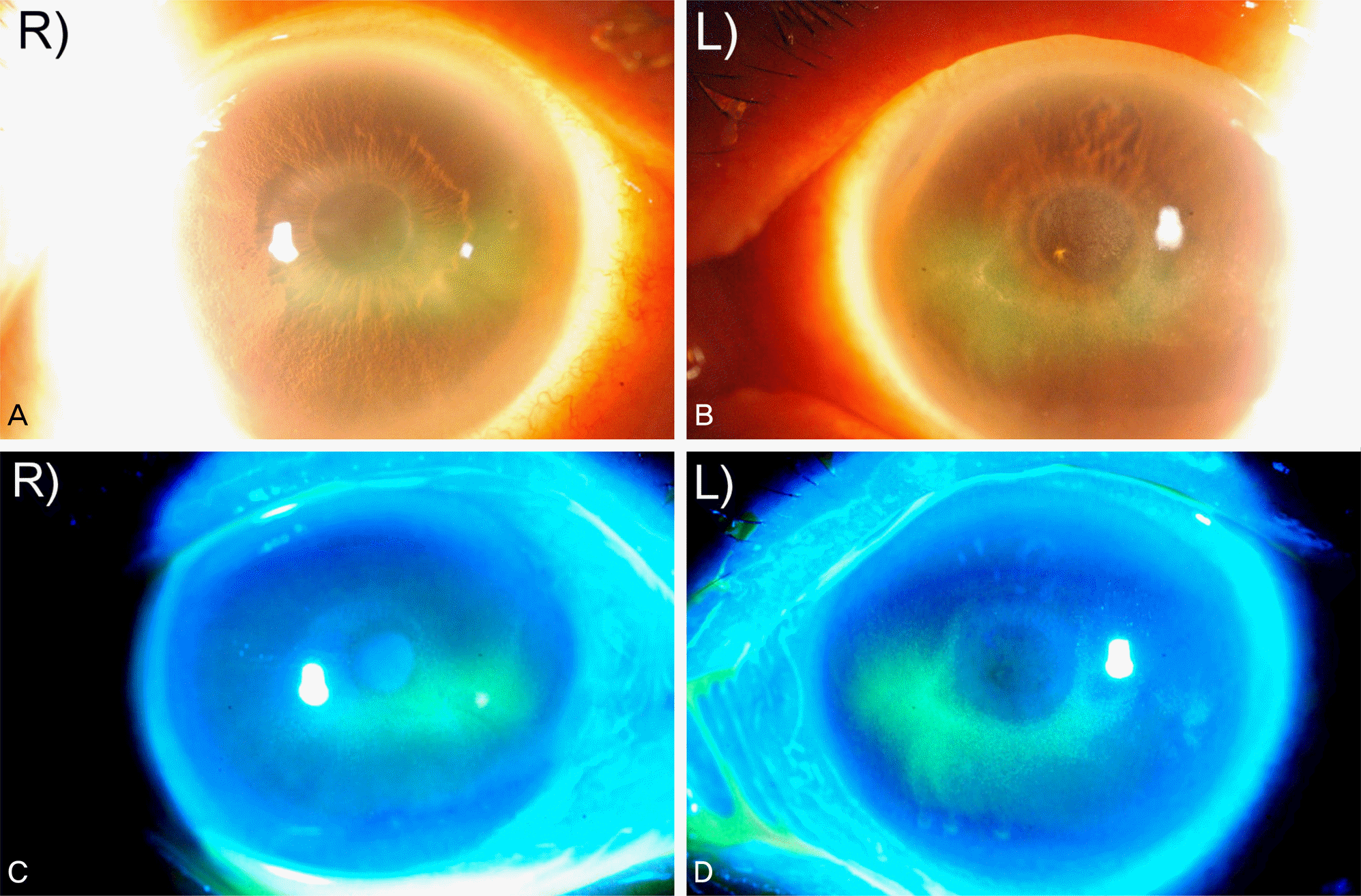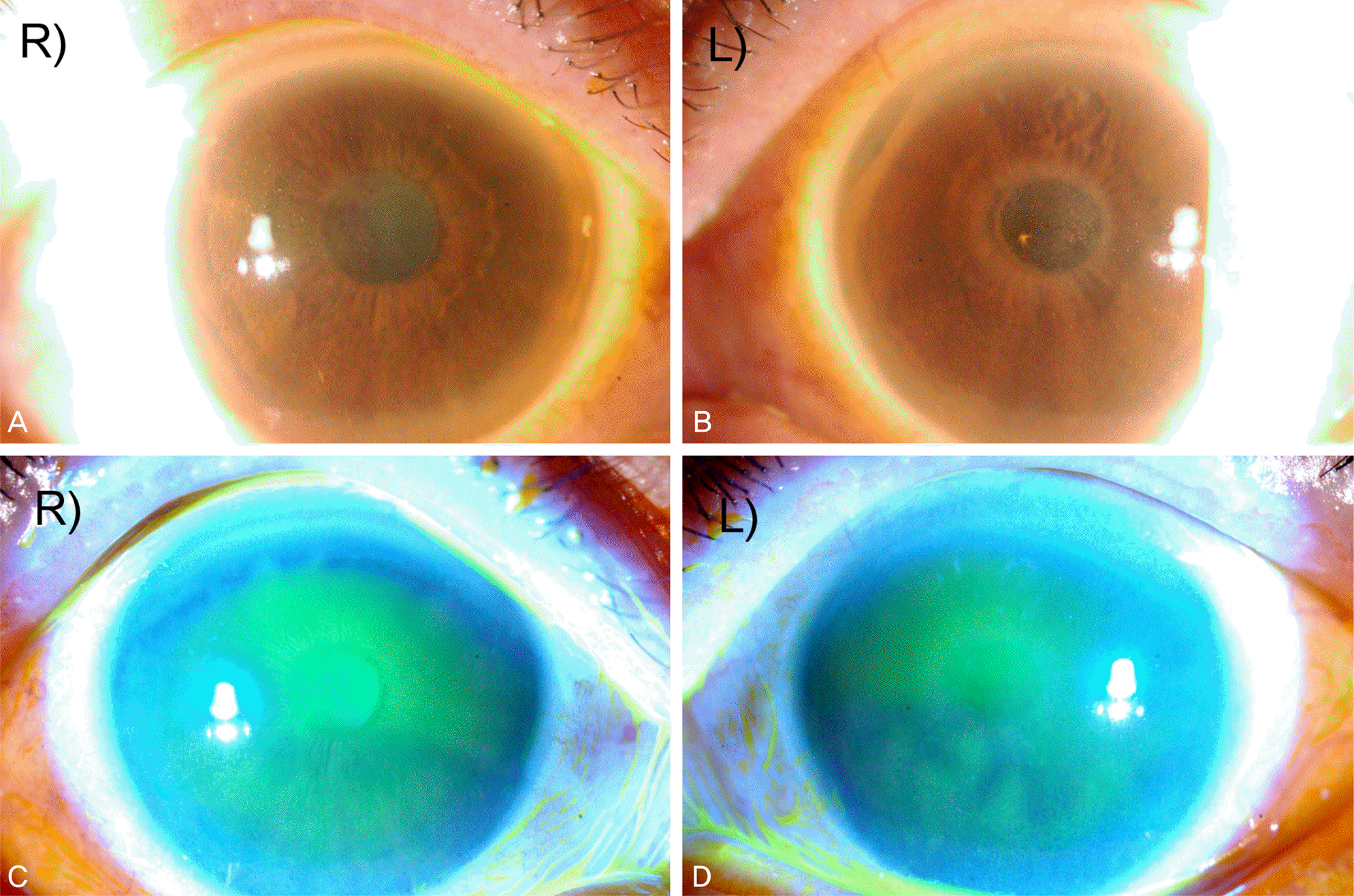Abstract
Case summary
A 74-year-old female visited our clinic with severe ocular pain and decreased vision in both eyes. She had received refractive surgeries in both eyes 10 years prior. She had been using sodium hyaluronate eyedrops for the treatment of dry eye symptoms for 10 years. Slit-lamp examination revealed inferior punctate erosions in the inferior part of the cornea in both eyes. With her history of chronic use of sodium hyaluronate and after ophthalmologic examination, we suspected keratitis medi-camentosa due to sodium hyaluronate eyedrops. We discontinued the eyedrops she was using and prescribed autologous serum. One month later, ocular discomfort and decreased vision were improved and corneal erosions were decreased.
Conclusions
In the present case, toxic keratitis was assumed to be associated with the use of sodium hyaluronate eyedrops and corneal erosions improved after the eyedrops were discontinued. We suggest sodium hyaluronate eyedrops are potentially haz-ardous and recommend a regular follow-up should be performed by a qualified ophthalmologist.
Go to : 
References
1. Research in dry eye: report of the Research Subcommittee of the International Dry Eye WorkShop (2007). Ocul Surf. 2007; 5:179–93.
2. Schein OD, Muñoz B, Tielsch JM. . Prevalence of dry eye among the elderly. Am J Ophthalmol. 1997; 124:723–8.

3. Lin PY, Tsai SY, Cheng CY. . Prevalence of dry eye among an elderly Chinese population in Taiwan: the Shihpai Eye Study. Ophthalmology. 2003; 110:1096–101.
4. Brewitt H, Sistani F. Dry eye disease: the scale of the problem. Surv Ophthalmol. 2001; 45(Suppl 2):S199–202.
5. Kim WJ, Kim HS, Kim MS. Current trends in the recognition and treatment of dry eye: a survey of ophthalmologists. J Korean Ophthalmol Soc. 2007; 48:1614–22.

6. Han SB, Hyon JY, Woo SJ. . Prevalence of dry eye disease in an elderly Korean population. Arch Ophthalmol. 2011; 129:633–8.

7. Stern ME, Gao J, Siemasko KF. . The role of the lacrimal functional unit in the pathophysiology of dry eye. Exp Eye Res. 2004; 78:409–16.

8. Dana MR, Hamrah P. Role of immunity and inflammation in corneal and ocular surface disease associated with dry eye. Adv Exp Med Biol. 2002; 506(Pt B):729–38.

9. Wilson FM 2nd. Adverse external ocular effects of topical ophthalmic medications. Surv Ophthalmol. 1979; 24:57–88.

10. Burstein NL. Preservative cytotoxic threshold for benzalkonium chloride and chlorhexidine digluconate in cat and rabbit corneas. Invest Ophthalmol Vis Sci. 1980; 19:308–13.
11. Coster DJ. Superficial keratopathy. Tasman W, Jaeger EA, editors. Duane's Clinical Ophthalmology. revised ed.Philadelphia: Lippincott;1995. v. 4:chap. 17.
12. Lemp MA. Advances in understanding and managing dry eye disease. Am J Ophthalmol. 2008; 146:350–6.

13. Schwab IR, Abbott RL. Toxic ulcerative keratopathy. An unrecognized problem. Ophthalmology. 1989; 96:1187–93.
14. Ichijima H, Petroll WM, Jester JV, Cavanagh HD. Confocal micro-scopic studies of living rabbit cornea treated with benzalkonium chloride. Cornea. 1992; 11:221–5.

15. Baudouin C, de Lunardo C. Short-term comparative study of topical 2% carteolol with and without benzalkonium chloride in healthy volunteers. Br J Ophthalmol. 1998; 82:39–42.
16. Ashton P, Diepold R, Platzer A, Lee VH. The effect of chlorhex-idine acetate on the corneal penetration of sorbitol from an arnolol formulation in the albino rabbit. J Ocul Pharmacol. 1990; 6:37–42.

17. Management and therapy of dry eye disease: report of the Management and Therapy Subcommittee of the International Dry Eye WorkShop (2007). Ocul Surf. 2007; 5:163–78.
Go to : 




 PDF
PDF ePub
ePub Citation
Citation Print
Print




 XML Download
XML Download